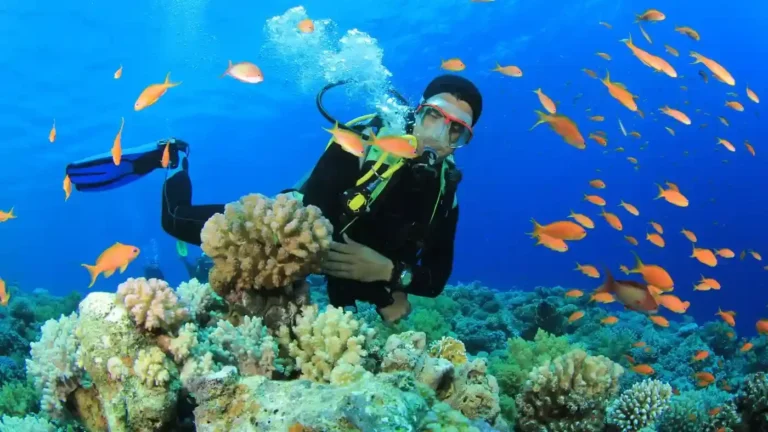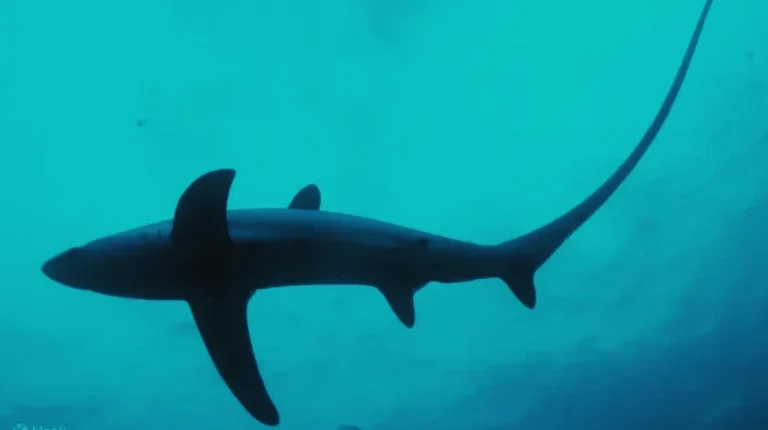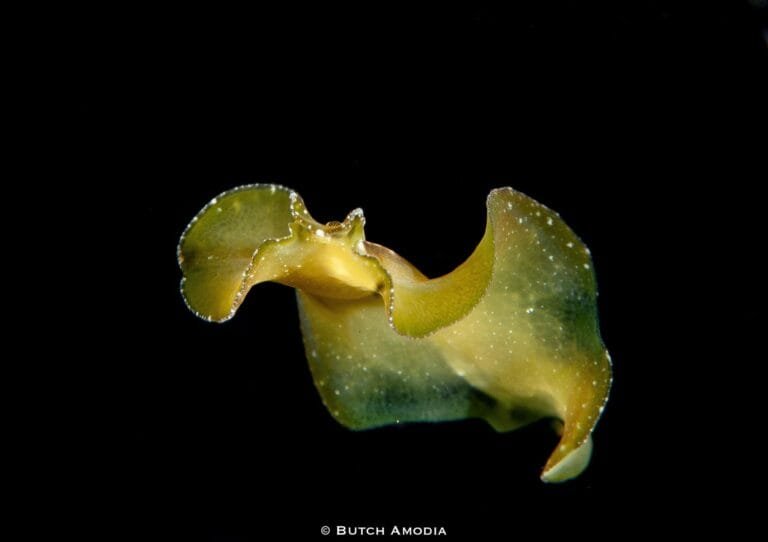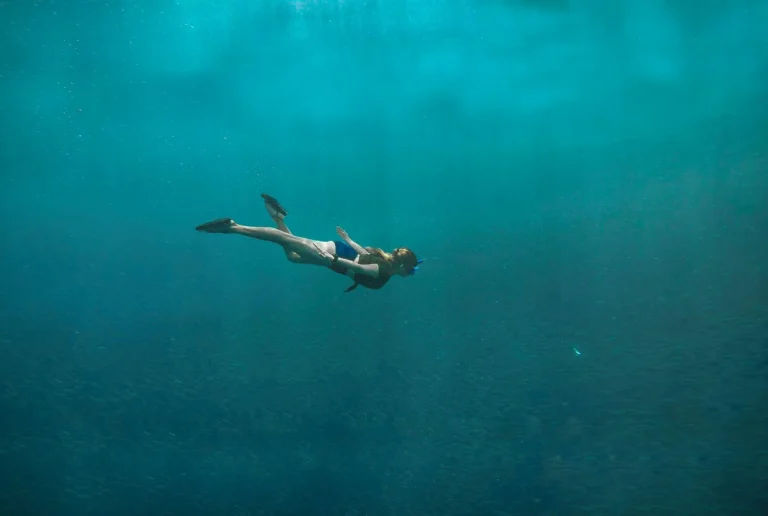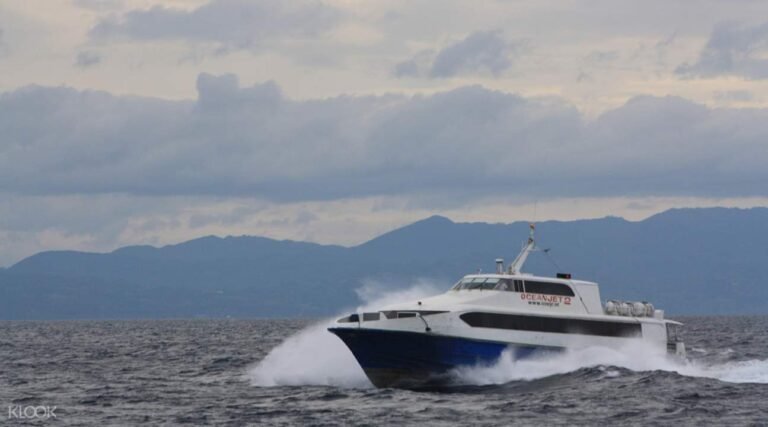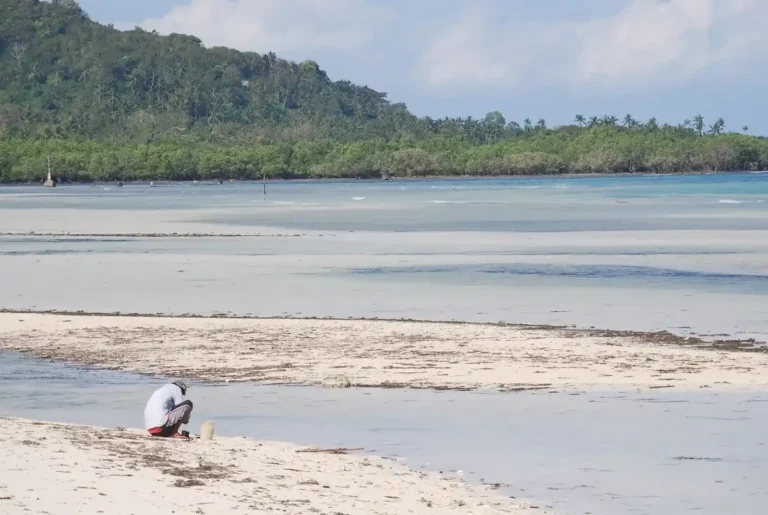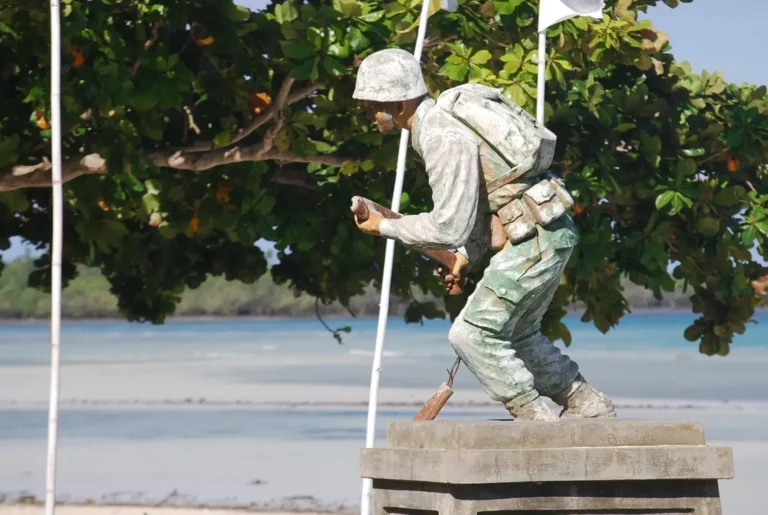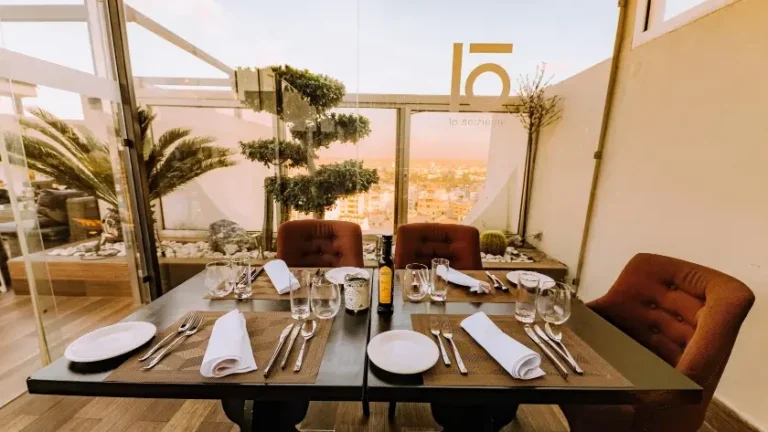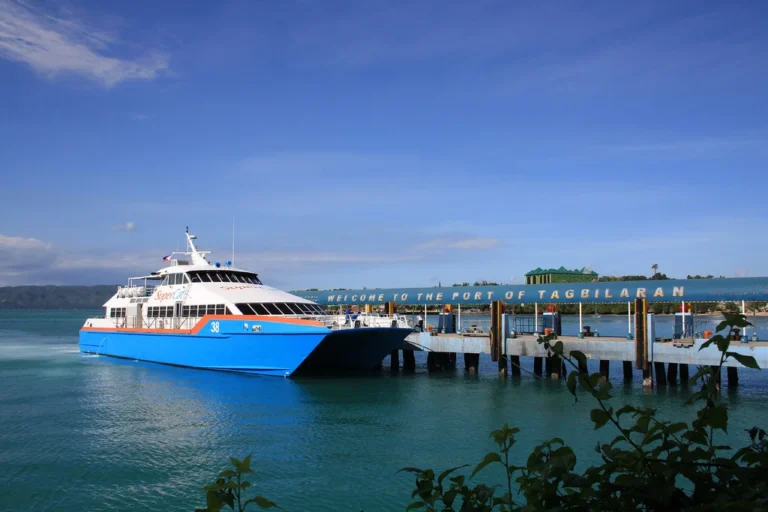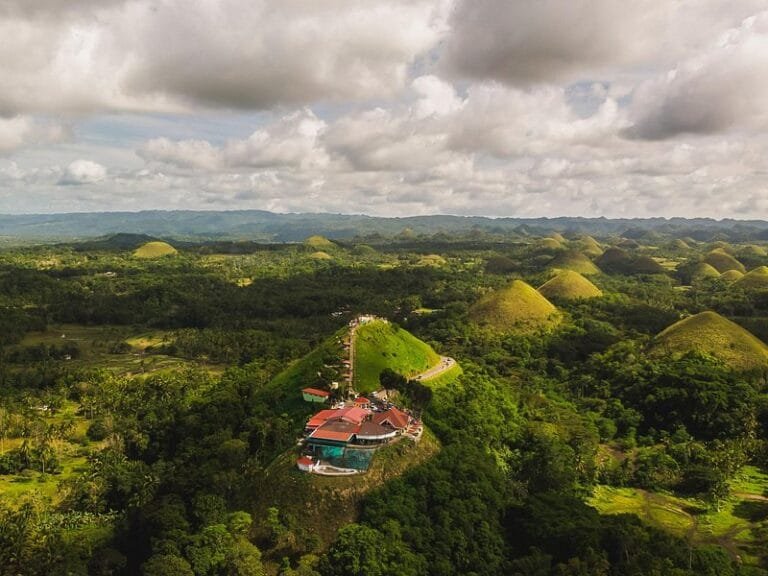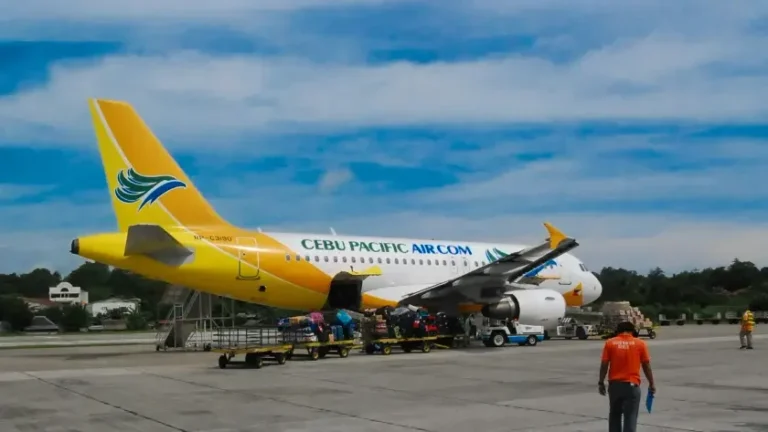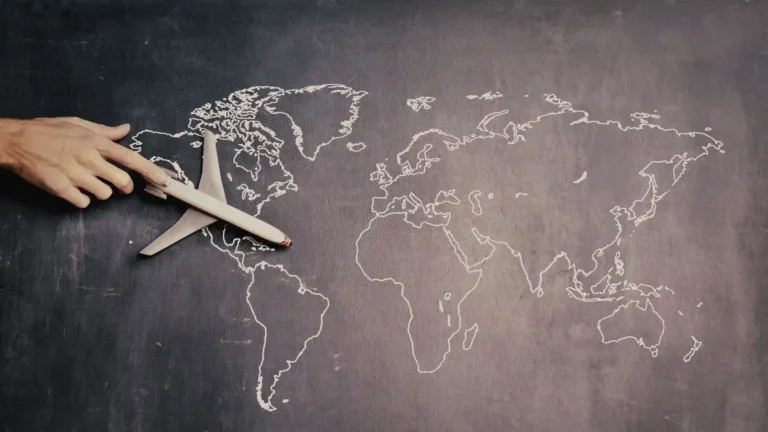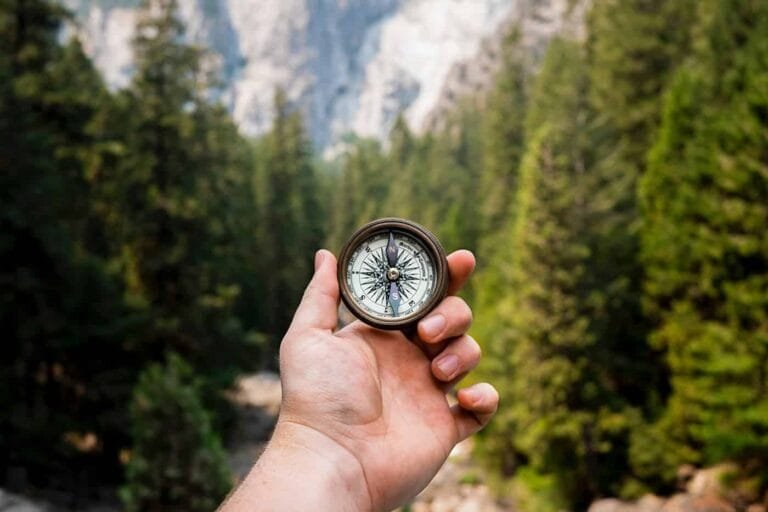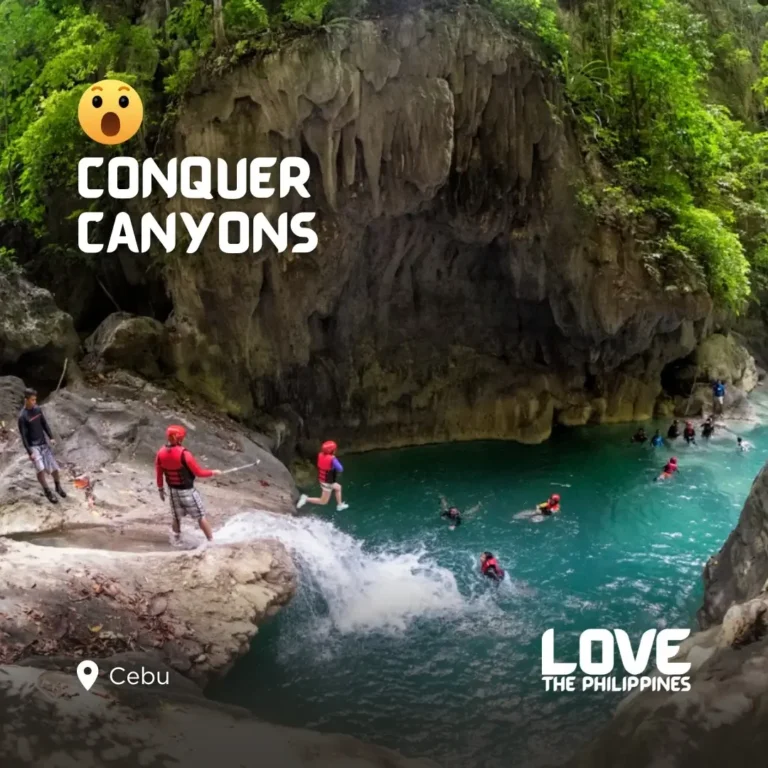Welcome to Malapascua Island, the only place on Earth where you can dive with thresher sharks on a near-daily basis. This tiny tropical paradise, just 2.5 kilometers long, has evolved from a sleepy fishing village into the Philippines’ premier diving destination.
With 98% thresher shark sighting success rates at depths accessible to advanced open water divers, Malapascua attracts serious underwater enthusiasts from around the globe. But beyond the legendary sharks, this island offers pristine white beaches, vibrant macro diving, mysterious cave systems, and a laid-back atmosphere that keeps visitors coming back.
Whether you’re here for world-class diving or seeking island tranquility, this comprehensive guide covers everything you need to plan the perfect Malapascua adventure.
Why Malapascua is the World’s Thresher Shark Capital
Malapascua’s claim to fame isn’t accidental—it’s the result of unique underwater geography and marine behavior patterns found nowhere else on the planet. Kimud Shoal and Monad Shoal, two underwater seamounts rising from depths of over 200 meters to just 14-25 meters below the surface, serve as natural cleaning stations where pelagic thresher sharks come each morning for their daily spa treatment.
The science behind the magic: Thresher sharks (Alopias pelagicus) normally inhabit deep waters far beyond recreational diving limits. However, these specific seamounts create upwelling currents that bring nutrient-rich water to shallow depths, attracting cleaner wrasse and other small fish. Between 6:00-9:00 AM daily, threshers rise from the depths to be cleaned of parasites—a behavior so predictable that dive operators guarantee sightings.
What makes this special: Unlike many shark diving destinations that rely on feeding or baiting, Malapascua’s encounters are 100% natural. The Thresher Research and Conservation Project has been studying these sharks since 2014, documenting individual animals and their cleaning behaviors. This sustainable approach means the experience remains authentic while supporting marine conservation.
“Diving with threshers at Kimud Shoal was the highlight of my 20-year diving career. The grace and size of these sharks in the early morning light is absolutely mesmerizing.” – Advanced Open Water Diver, Germany ⭐⭐⭐⭐⭐
Current success rates: Kimud Shoal reports 95-98% thresher sightings year-round, with peak encounters January-April when visibility reaches 25-30 meters. Even during monsoon months (July-October), success rates remain above 85%.
Complete Transportation Guide – Getting to Malapascua
Getting to Malapascua requires patience and planning, but the journey has become significantly easier with improved transportation options. Here’s your complete logistics guide:
Flight Options to Northern Cebu
Option 1: Cebu City Route (Most Common)
- Fly to: Mactan-Cebu International Airport (CEB)
- Airlines: Cebu Pacific, Philippine Airlines, AirAsia from Manila (1.5 hours), international connections available
- Pros: Most flight options, established route, easy onward connections
- Cons: Longest total travel time to Malapascua
Option 2: Direct to Bantayan Airport (New Option – 2024)
- Fly to: Bantayan Airport (SFE)
- Airlines: Limited flights from Manila and Cebu
- Pros: Closer to Maya Port, reduced total travel time
- Cons: Limited flight schedules, higher costs, newer route with potential delays
Land Transportation: Cebu to Maya Port
Private Van/Car (Recommended for Divers with Gear)
- Duration: 4-5 hours from Cebu City
- Cost: ₱8,000-₱12,000 for entire van (up to 8 people)
- Pros: Direct route, gear storage, flexible timing, AC comfort
- Book through: Dive centers can arrange, or book via Klook/GetYourGuide
Public Bus (Budget Option)
- Route: Cebu North Bus Terminal → Bogo City → Maya Port
- Duration: 5-6 hours including transfers
- Cost: ₱200-₱300 per person
- Buses: Ceres Bus lines, departures every hour 6:00 AM – 6:00 PM
- Note: Not ideal with heavy dive equipment
Habal-Habal Final Stretch (Maya Town to Maya Port)
- Duration: 15 minutes
- Cost: ₱50-₱100 per person depending on luggage
- Essential: Buses drop in Maya town, port is separate location
Ferry to Malapascua
Standard Bangka Boats
- Duration: 30-45 minutes depending on weather
- Cost: ₱80-₱150 per person + ₱20-₱50 for luggage
- Schedule: 6:30 AM – 4:30 PM (weather dependent)
- Frequency: Every 30-60 minutes when full
Private Boat Charter
- Duration: 30 minutes
- Cost: ₱3,000-₱5,000 for entire boat
- When to use: Large groups, heavy equipment, missed last ferry
- Booking: Arrange through accommodation or dive centers
Total Journey Times & Costs
| Route | Duration | Budget Cost | Premium Cost |
| Manila → Cebu → Maya → Malapascua | 8-10 hours | ₱4,500-₱6,000 | ₱12,000-₱18,000 |
| Cebu City → Maya → Malapascua | 5-7 hours | ₱500-₱800 | ₱8,500-₱12,500 |
| Bantayan Airport → Maya → Malapascua | 3-4 hours | ₱1,200-₱1,800 | ₱6,000-₱8,000 |
Weather considerations: Monsoon season (July-October) can delay or cancel ferries. Always have backup plans and flexible accommodation during these months.
Diving Malapascua – Complete Guide to Thresher Encounters
The Famous Dive Sites
Kimud Shoal (Current Thresher Hotspot)
- Depth: 14-25 meters
- Certification: Advanced Open Water minimum
- Best conditions: 6:30-8:30 AM departures
- What to expect: 1-5 thresher sharks per dive, cleaning behavior, occasional hammerheads (January-April)
- Bottom time: 40-50 minutes
- Why here: Shallower than Monad Shoal, more predictable encounters since 2018
Monad Shoal (Original Thresher Site)
- Depth: 20-30 meters
- Certification: Advanced Open Water minimum
- Current status: Fewer threshers, but tiger sharks and bull sharks frequent visitors
- Best for: Experienced divers seeking bigger pelagics
- Note: Some operators still visit for variety, but Kimud Shoal has better shark rates
Gato Island (Advanced Diving Adventure)
- Distance: 45 minutes by boat from Malapascua
- Depth: 5-40 meters
- Highlights: Underwater tunnel, white-tip reef sharks, sea snakes, macro life
- Certification: Advanced Open Water for tunnel swim-through
- Best time: All day diving available, less weather dependent
Dive Operator Comparison & Recommendations
Premium Tier – Professional Excellence
Evolution Diving Malapascua
- Specialty: Technical diving, CCR training, deep specialties
- Perfect for: Serious divers, underwater photographers, technical advancement
- Pricing: ₱2,100 per dive (with equipment), ₱1,850 (own gear)
- Packages: 10+ dives at ₱1,890 (with equipment), ₱1,665 (own gear)
- Strengths: TDI technical center, excellent safety record, small groups, gear quality
- Accommodation: Own guesthouse and restaurant on-site
- Book when: You want technical training or serious photography guidance
Thresher Shark Divers (Island Pioneers)
- History: First to discover thresher diving spots, 20+ years experience
- Perfect for: First-time thresher divers, certification courses, reliability
- Pricing: Competitive with island standards, package deals available
- Strengths: Local knowledge, PADI certification center, established reputation
- Accommodation: Partner resorts on Bounty Beach
- Book when: You want proven track record and traditional experience
Mid-Range Professional
Exotic Island Diving
- Perfect for: Budget-conscious divers still wanting quality
- Pricing: ₱1,800-₱2,000 per dive
- Strengths: Good safety standards, friendly staff, flexible scheduling
- Accommodation: Own resort property available
- Book when: Balancing cost with professional service
Ocean Vida Beach & Dive Resort
- Perfect for: Resort-based diving with luxury accommodations
- Specialty: Beginner-friendly, resort course offerings
- Strengths: All-inclusive packages, spa services, yoga classes
- Book when: Combining luxury accommodation with diving
Seasonal Diving Conditions
Peak Season (January-April)
- Visibility: 25-30 meters
- Sea conditions: Calm, minimal swell
- Thresher activity: Highest encounter rates, predictable timing
- Crowds: Busiest period, book accommodations 60+ days ahead
- Weather: Sunny, dry, ideal for surface intervals
Shoulder Season (May-June, November-December)
- Visibility: 20-25 meters
- Sea conditions: Generally good with occasional rougher days
- Thresher activity: Still excellent (90%+ sightings)
- Crowds: Moderate, good availability
- Weather: May has some rain, November-December can be choppy
Monsoon Season (July-October)
- Visibility: 15-20 meters (still diveable)
- Sea conditions: Rougher seas, some trip cancellations
- Thresher activity: 85%+ sightings, sharks still predictable
- Crowds: Lowest, excellent accommodation deals
- Weather: Expect rain, potential typhoons, flexible planning essential
Certification Requirements & Training
Minimum for Thresher Dives: Advanced Open Water (Deep Dive and Navigation specialties)
Recommended upgrades on Malapascua:
- Nitrox Certification: Longer bottom times at cleaning stations
- Deep Diving Specialty: Safer profiles for 25-30 meter dives
- Underwater Photography: Maximize thresher encounter documentation
Technical diving progression: Evolution Diving offers full TDI programs for those wanting to explore deeper sites around Malapascua.
🦈 Book Your Thresher Shark Adventure
✅ 98% shark encounter success rate
🤿 Advanced Open Water minimum required
📸 Underwater photography courses available
⏰ Peak season filling fast – book 60 days ahead!
👉 [Book with Evolution Diving] | [Compare Dive Centers] – Guaranteed shark encounters await!
Accommodation Guide – Where to Stay by Travel Style
Choosing the right location on Malapascua dramatically impacts your experience. The island’s small size means everything is within 20 minutes, but strategic placement saves time and matches your priorities.
Bounty Beach – Heart of Tourism
Best for: First-time visitors, social travelers, easy access to restaurants and nightlife Pros: Walking distance to most dive shops, restaurants, bars, stunning sunsets Cons: Can be crowded, some construction noise, higher prices
Luxury Options
Ocean Vida Beach & Dive Resort (₱8,000-₱12,000/night)
- Perfect for: Luxury divers wanting full-service experience
- Features: Beachfront location, dive center on-site, spa services, yoga classes
- Rooms: Modern with AC, private terraces, sea views
- Dining: International cuisine, healthy options, sunset bar
- Book when: Budget allows premium experience with diving convenience
Exotic Island Dive & Beach Resort (₱6,000-₱9,000/night)
- Perfect for: Established diving operation with comfortable accommodation
- Features: Pioneer dive resort, beachfront, multiple room categories
- Rooms: Range from standard to suites, reliable AC and WiFi
- Dining: Resort restaurant, known for fresh seafood
- Book when: Want proven diving operation with solid accommodation
Mid-Range Excellence
Tepanee Beach Resort (₱3,500-₱5,500/night)
- Perfect for: Quality without luxury prices, southern Bounty Beach location
- Features: Quieter section of beach, good snorkeling from shore
- Rooms: Clean, comfortable, reliable amenities
- Dining: Beachfront restaurant, casual atmosphere
- Book when: Seeking balance of location, quality, and value
Devocean Divers Lodge (₱3,000-₱4,500/night)
- Perfect for: Divers wanting green/sustainable operation
- Features: Green Fins certified dive center, environmental focus
- Rooms: Eco-friendly design, comfortable basics
- Dining: Organic/local focus when possible
- Book when: Sustainability matters in your travel choices
Budget Smart Choices
Ging-Ging’s Flower Garden (₱1,200-₱2,000/night)
- Perfect for: Budget travelers wanting Bounty Beach location
- Features: Garden setting, basic but clean rooms
- Rooms: Fan or AC options, shared or private bath
- Book when: Location matters more than amenities
Logon Beach – Peaceful Alternative
Best for: Couples, mature travelers, those seeking tranquility Pros: Quieter beach, beautiful sunrise views, less crowded Cons: 10-minute walk to main restaurants, fewer immediate dining options
Top Picks
Kokay’s Maldito Dive Resort (₱4,000-₱6,500/night)
- Perfect for: Peaceful luxury with diving convenience
- Features: Southern tip location, dive operation, stunning cliff-top restaurant
- Rooms: Spacious, modern amenities, sea or garden views
- Dining: Amihan restaurant with best views on island
- Book when: Want luxury with tranquility over party scene
Amihan Beach Cabanas (₱2,500-₱4,000/night)
- Perfect for: Mid-range comfort in peaceful setting
- Features: Traditional nipa hut style, beachfront location
- Rooms: Filipino charm with modern conveniences
- Book when: Cultural authenticity with comfort matters
Maya Port Area – Transit Hub
Best for: Late arrivals, early departures, budget-conscious travelers Pros: Easy ferry access, lower costs, local atmosphere Cons: Not beachfront, limited tourism infrastructure
Budget Option: D&N Lodge (₱800-₱1,500/night)
- When to use: Missed last ferry, very early departure, tight budget
- Features: Basic but clean, near port, AC available
Accommodation Booking Strategy
Peak Season (January-April):
- Book 60-90 days ahead for best properties
- Expect 30-50% price increases during Holy Week
- Consider package deals with dive operators
Off-Season (July-October):
- Book 14-30 days ahead for flexibility
- Prices drop 20-40%, excellent value opportunities
- Some properties close for maintenance
Package Deals vs. Individual Booking:
- Dive + accommodation packages often save 15-25%
- Individual booking offers more flexibility for non-divers
- Compare total costs including meals and activities
Beyond Diving – Malapascua’s Hidden Attractions
While thresher sharks dominate the headlines, Malapascua offers diverse experiences for non-divers and surface intervals between dives.
Beach Paradise Activities
Bounty Beach – Sunset Central
- What makes it special: 2.5-kilometer stretch of powdery white sand facing west
- Best activities: Sunset watching (6:00-6:30 PM), beach volleyball, stand-up paddleboarding
- Swimming conditions: Generally safe, watch for boats in designated areas
- Peak times: Late afternoon for golden hour photography
Langob Beach – Sunrise Sanctuary
- What makes it special: East-facing beach perfect for sunrise (5:30-6:00 AM)
- Best activities: Morning walks, fishing with locals, quiet contemplation
- Swimming conditions: Calmer waters, good for beginners
- Local tip: Local fishermen launch boats here at dawn – respect their work areas
Island Hopping Adventures
Kalanggaman Island Day Trip
- Distance: 1.5 hours by boat from Malapascua
- Highlights: Famous sandbar, crystal-clear waters, snorkeling, Instagram-worthy shots
- Duration: Full day (8:00 AM – 4:00 PM)
- Cost: ₱2,500-₱3,500 per person including boat, lunch, snorkeling gear
- Book through: Any dive center or accommodation can arrange
Bantayan Island Connection
- Distance: 2 hours by boat
- Highlights: Virgin Island cliff jumping, Ogtong Cave, different island culture
- Best for: Multi-day island hopping, those with extra time
- Logistics: Can be combined with departure via Bantayan Airport
Cultural & Historical Experiences
Local Village Tours
- Highlights: Traditional fishing methods, boat building, local family interactions
- Duration: 2-3 hours
- Cost: ₱1,000-₱1,500 per person with guide
- Best time: Late afternoon when fishermen return
Traditional Craft Workshops
- Available: Basket weaving, shell craft making, cooking classes
- Where: Arrange through accommodation or local guides
- Cost: ₱500-₱1,200 per person depending on activity
- Take home: Handmade souvenirs and new skills
Adventure Activities for Active Travelers
Island Circumnavigation by Motorbike
- Duration: 2-3 hours at relaxed pace
- Rental cost: ₱400-₱600 per day
- Highlights: Hidden beaches, local villages, cliff viewpoints
- Essential: Helmet provided, driver’s license required, respect local traffic
Snorkeling from Shore
- Best spots: Tepanee Beach Resort area (southern Bounty Beach)
- What to see: Juvenile blacktip reef sharks, tropical fish, coral gardens
- Equipment rental: ₱200-₱300 per day from multiple shops
- Safety tip: Always snorkel with buddy, respect coral reef
Cliff Jumping (When Accessible)
- Location: Various spots around island (access varies by land ownership)
- Heights: 3-8 meters
- Safety: Local guides essential, check water depth, assess conditions
- Note: Access has become more restricted; confirm current availability
Relaxation & Wellness
Beach Massage Services
- Where: Along Bounty Beach, multiple operators
- Cost: ₱500-₱800 per hour
- Types: Traditional Filipino hilot, Swedish, reflexology
- Peak times: Late afternoon after diving, sunset sessions popular
Yoga & Meditation
- Ocean Vida Resort: Daily yoga classes, meditation sessions
- Beach yoga: Independent instructors offer sunrise/sunset sessions
- Cost: ₱300-₱500 per session
- Book: Through accommodations or ask at reception areas
Nightlife & Evening Entertainment
Beach Bar Scene
- Amihan Cliff-Top Bar: Best sunset views, craft cocktails, elevated atmosphere
- Bounty Beach Bars: Multiple casual spots, live music some evenings
- Happy hour: Most bars 5:00-7:00 PM
Local Music & Culture
- Filipino karaoke: Available at most restaurants/bars
- Live acoustic music: Several venues feature local musicians
- Cultural shows: Occasionally arranged during peak season
🏝️ Complete Your Malapascua Experience
✅ Dive with threshers in morning, island hop in afternoon
🌅 Catch sunrise at Langob, sunset at Bounty Beach
🏍️ Motorbike around island for hidden gems
⏰ Peak season activities book quickly!
👉 [Book Island Hopping] | [Rent Motorbike] – Beyond diving adventures await!
Food & Dining Guide – From Beach Bars to Hidden Gems
Malapascua’s dining scene has evolved dramatically, offering everything from fresh-caught seafood to international cuisine that rivals major tourist destinations.
Must-Try Local Specialties
Fresh Seafood Daily Catches
- Best places: Beachfront restaurants along Bounty Beach
- Signature dishes: Grilled lapu-lapu, kinilaw (Filipino ceviche), grilled squid
- Pricing: ₱400-₱800 for whole fish (serves 2-3 people)
- Local tip: Ask to see the fish before ordering to ensure freshness
Traditional Filipino Breakfast
- Where to find: Local carinderias (small family restaurants) in village area
- Must try: Tapsilog (beef tapa, garlic rice, fried egg), bangus (milkfish), longanisa
- Cost: ₱150-₱250 per meal
- Best time: 7:00-9:00 AM before diving
Top Restaurant Recommendations
Upscale Dining
Amihan sa Nalusuan Restaurant (Kokay’s Maldito)
- Cuisine: International with Filipino fusion
- Signature: Cliff-top dining with panoramic ocean views
- Price range: ₱800-₱1,500 per person
- Must order: Grilled seafood platter, sunset cocktails
- Reservation: Essential for dinner, especially sunset timing
Ocean Vida Restaurant
- Cuisine: Health-conscious international, vegetarian-friendly
- Signature: Fresh salads, smoothie bowls, grilled fish
- Price range: ₱600-₱1,200 per person
- Must order: Poke bowls, fresh fruit smoothies
- Best for: Health-conscious divers, yoga practitioners
Casual Beachfront Favorites
Ging-Ging’s Restaurant
- Cuisine: Filipino comfort food, fresh seafood
- Signature: Family-style portions, local atmosphere
- Price range: ₱300-₱600 per person
- Must order: Grilled fish, pancit canton, fresh mango
- Best for: Authentic local experience, budget-friendly
Crudo Bar
- Cuisine: Italian-inspired, wood-fired pizza
- Signature: Thin-crust pizzas, pasta dishes, craft cocktails
- Price range: ₱500-₱900 per person
- Must order: Margherita pizza, fresh pasta with seafood
- Best for: Western comfort food after diving
Coffee & Breakfast Spots
Evolution Café (Evolution Diving)
- Specialty: Barista-quality coffee, served in thresher shark mugs
- Menu: International breakfast, healthy options
- Hours: 6:00 AM – 10:00 PM (essential for early diving)
- Must try: Specialty coffee blends, avocado toast
Island Life Café
- Specialty: Fresh fruit smoothies, açai bowls
- Menu: Light breakfast, vegan options available
- Hours: 7:00 AM – 6:00 PM
- Must try: Mango smoothie bowl, coconut coffee
Budget-Friendly Local Eats
Malapascua Public Market Food Stalls
- Cuisine: Authentic Filipino street food
- Specialties: Grilled corn, barbecue skewers, fresh tropical fruits
- Price range: ₱50-₱150 per item
- Hours: 6:00 AM – 8:00 PM
- Local tip: Busiest during lunch and early dinner
Village Carinderias
- What they are: Family-run restaurants serving home-style cooking
- Menu style: Point and choose from displayed dishes
- Price range: ₱100-₱250 per meal
- Best for: Authentic experience, very budget-friendly
Dining Tips & Etiquette
Meal Timing Strategy:
- Early breakfast: 6:00-7:00 AM before thresher shark dives
- Post-dive brunch: 9:30-11:00 AM after morning diving
- Late lunch: 2:00-4:00 PM between dive sessions
- Sunset dinner: 6:00-8:00 PM for best atmosphere
Food Safety Considerations:
- Stick to busy restaurants with high turnover
- Ensure fish is fresh (clear eyes, firm flesh)
- Bottled water recommended over ice in remote areas
- Street food from busy stalls generally safe
Dietary Restrictions:
- Vegetarian options widely available at tourist restaurants
- Vegan choices more limited, communicate needs clearly
- Gluten-free awareness varies, bring essentials if severe celiac
- Local staff generally accommodating with advance notice
Weather, Seasons & Best Time to Visit
Understanding Malapascua’s weather patterns is crucial for optimizing your diving experience and overall trip satisfaction.
Detailed Seasonal Breakdown
Peak Dry Season (January-April)
- Weather: Sunny, dry, minimal rainfall
- Sea conditions: Calm, excellent visibility (25-30m)
- Air temperature: 26-30°C (79-86°F)
- Water temperature: 27-28°C (81-82°F)
- Wind: Light easterly trade winds
- Diving: Best conditions for thresher encounters and photography
- Crowds: Highest tourist numbers, advance booking essential
- Pricing: Peak rates for accommodation and activities
Shoulder Season 1 (May-June)
- Weather: Increasing humidity, occasional afternoon showers
- Sea conditions: Generally good, some choppier days
- Air temperature: 28-32°C (82-90°F)
- Water temperature: 28-29°C (82-84°F)
- Diving: Still excellent visibility (20-25m), fewer crowds
- Crowds: Moderate numbers, good availability
- Pricing: Moderate rates, good value period
Wet Season (July-October)
- Weather: Regular rainfall, potential typhoons
- Sea conditions: Rougher seas, some dive cancellations
- Air temperature: 26-30°C (79-86°F)
- Water temperature: 27-28°C (81-82°F)
- Diving: Reduced visibility (15-20m) but still productive
- Crowds: Lowest numbers, excellent deals
- Pricing: Lowest rates, some properties close for maintenance
Shoulder Season 2 (November-December)
- Weather: Transitioning to dry, occasional rain
- Sea conditions: Improving, but still variable
- Air temperature: 26-29°C (79-84°F)
- Water temperature: 27-28°C (81-82°F)
- Diving: Good conditions returning, increasing visibility
- Crowds: Building toward peak season
- Pricing: Rising from low season to peak rates
Month-by-Month Diving Conditions
| Month | Visibility | Sea State | Thresher Rate | Crowds | Value Rating |
| January | 25-30m | Excellent | 98% | High | ★★★☆☆ |
| February | 25-30m | Excellent | 98% | High | ★★★☆☆ |
| March | 25-30m | Excellent | 95% | Very High | ★★☆☆☆ |
| April | 20-25m | Very Good | 95% | Very High | ★★☆☆☆ |
| May | 20-25m | Good | 90% | Moderate | ★★★★☆ |
| June | 18-22m | Good | 90% | Moderate | ★★★★☆ |
| July | 15-20m | Variable | 85% | Low | ★★★★★ |
| August | 15-20m | Variable | 85% | Low | ★★★★★ |
| September | 15-18m | Poor-Fair | 80% | Very Low | ★★★☆☆ |
| October | 18-22m | Fair-Good | 85% | Low | ★★★★☆ |
| November | 20-25m | Good | 90% | Moderate | ★★★★☆ |
| December | 22-28m | Very Good | 95% | Moderate | ★★★★☆ |
Weather-Related Safety Considerations
Typhoon Season Awareness (June-November)
- Monitor Philippine weather forecasts closely
- Have flexible travel insurance covering weather delays
- Local dive operators excellent at weather assessment
- Alternative activities available during rough weather
Seasonal Packing Recommendations
Dry Season (January-May):
- Light, breathable clothing
- Strong reef-safe sunscreen (SPF 50+)
- Light rain jacket for afternoon showers
- Minimal warm clothing needed
Wet Season (June-October):
- Quick-dry clothing essential
- Waterproof gear bag for electronics
- Light wetsuit or rash guard for cooler water
- Flexible mindset for weather delays
Optimal Visit Timing by Travel Goals
Best for Thresher Shark Diving: January-April (peak visibility and encounter rates)
Best Value for Money: July-August (lowest prices, still good diving)
Best Weather + Value Balance: May, November (good conditions, moderate prices)
Best for Avoiding Crowds: September-October (lowest tourist numbers)
Best for Island Hopping: December-April (calm seas for boat trips)
Budget Planning & Money-Saving Tips
Daily Budget Expectations
Budget Traveler (₱2,000-₱3,500/day)
- Accommodation: ₱1,000-₱1,500 (dorm or basic room)
- Food: ₱600-₱900 (local restaurants, some street food)
- Activities: ₱400-₱600 (non-diving activities, snorkeling)
- Transport: ₱200-₱300 (local transport, motorbike rental)
Mid-Range Traveler (₱4,500-₱8,000/day)
- Accommodation: ₱3,000-₱5,000 (comfortable resort)
- Food: ₱1,200-₱2,000 (mix of tourist and local restaurants)
- Activities: ₱2,000-₱3,000 (2 dives per day average)
- Transport: ₱300-₱500 (private transfers, convenience)
Luxury Traveler (₱10,000+/day)
- Accommodation: ₱8,000-₱15,000 (premium beachfront)
- Food: ₱2,500-₱4,000 (resort dining, sunset restaurants)
- Activities: ₱3,500-₱5,500 (premium dive packages, private tours)
- Transport: ₱1,000-₱2,000 (private boats, convenience)
Diving Cost Breakdown
Individual Dive Pricing:
- Single dive with equipment: ₱1,800-₱2,200
- Single dive with own gear: ₱1,400-₱1,800
- Thresher shark specialty dive: ₱2,200-₱2,800
- Nitrox surcharge: ₱200-₱300 per dive
Package Savings:
- 5-dive package: Save 10-15%
- 10-dive package: Save 15-20%
Package Savings (continued):
- Open Water + Advanced certification combo: Save 20-25%
- Accommodation + diving packages: Save 15-30% total
Equipment Rental Costs:
- Full gear set: ₱300-₱500 per dive
- Wetsuit only: ₱100-₱150 per dive
- Underwater camera: ₱800-₱1,200 per day
- Nitrox tank upgrade: ₱200-₱300 per dive
Money-Saving Strategies
Advance Booking Discounts:
- Book 60+ days ahead for 10-15% accommodation savings
- Dive packages booked with accommodation save additional 10-20%
- Off-season bookings (July-October) offer 25-40% discounts
Group Booking Benefits:
- 4+ people: Private boat charters become cost-effective
- 6+ divers: Negotiate group rates with dive centers
- Shared accommodation: Villa rentals cheaper than individual rooms
Local Money-Saving Tips:
- Eat at village carinderias for ₱100-₱200 meals vs. ₱600+ tourist restaurants
- Rent motorbike for ₱400/day vs. ₱150-₱200 per tricycle trip
- Buy snacks at public market vs. resort shops (50-70% savings)
- Share boat transfers from Maya Port (₱80 vs. ₱3,000+ private charter)
Hidden Costs to Budget For
Transportation Extras:
- Maya Port habal-habal: ₱50-₱100 (often not mentioned)
- Luggage fees on bangka: ₱20-₱50 per bag
- Private airport transfers: ₱8,000-₱12,000 (vs. ₱500 public transport)
Diving Add-ons:
- Marine park fees: ₱100-₱200 per dive site
- Equipment insurance: ₱50-₱100 per day
- Underwater photos/videos: ₱800-₱2,000 per dive
- Certification card replacement: ₱500-₱1,000
Island Living Extras:
- ATM fees: ₱250+ per withdrawal (limited ATMs)
- Resort WiFi: Some charge ₱100-₱200/day
- Laundry service: ₱50-₱100 per piece
- Motorbike fuel: ₱200-₱300 for full island tour
Essential Packing Guide for Malapascua
Diving Gear Essentials
Must-Bring Items:
- Mask & Snorkel: Personal fit essential, backup mask recommended
- Wetsuit: 3mm minimum, 5mm for comfort in 27-28°C water
- Dive Computer: Essential for repetitive thresher shark dives
- Underwater Camera: GoPro or similar, extra batteries/memory cards
- Certification Cards: Physical cards required, bring PADI/SSI logbook
Consider Bringing:
- Fins: Good rentals available, but personal fit preferred
- BCD & Regulator: Quality rentals available, saves luggage space/weight
- Dive Light: Essential for early morning thresher dives, cave/wreck exploration
Photography Gear:
- Underwater housing: For DSLR/mirrorless cameras
- Strobes/lights: Rental available but expensive (₱1,500+/day)
- Memory cards: Multiple high-capacity cards
- Dry bag: Protect equipment between dives
Tropical Island Essentials
Sun Protection:
- Reef-safe sunscreen: SPF 50+, zinc oxide/titanium dioxide based
- Rash guard: Long-sleeve for diving and beach activities
- Wide-brimmed hat: Essential for boat trips and beach time
- Sunglasses: Polarized recommended for water glare
Clothing for Tropical Climate:
- Quick-dry shorts/shirts: 3-4 changes minimum
- Light rain jacket: Compact, essential during wet season
- Flip-flops: Beach and casual wear
- Water shoes: Rocky entries, some dive sites require
- Light sweater: AC in rooms can be cold, evening boat trips
Health & Safety Items:
- First aid kit: Band-aids, antiseptic, pain relievers
- Insect repellent: DEET-based for tropical effectiveness
- Water purification tablets: Backup for remote areas
- Prescription medications: Bring extra supply
- Travel insurance documents: Print and digital copies
Electronics & Technology
Essential Electronics:
- Waterproof phone case: Beach and boat protection
- Power bank: Multiple charges for long diving days
- Universal adapter: Filipino outlets use US-style plugs
- Headlamp/flashlight: Power outages common, night activities
Camera Equipment:
- Underwater camera: GoPro, housing for DSLR/mirrorless
- Extra batteries: Camera batteries drain quickly in cold water
- Memory cards: Multiple high-capacity cards for video
- Lens cleaning kit: Salt spray affects all equipment
Seasonal Packing Adjustments
Dry Season (January-May):
- Lighter clothing focus
- Maximum sun protection
- Minimal rain gear needed
- Focus on heat management
Wet Season (June-October):
- Waterproof bags essential
- Quick-dry everything
- Light jacket for cooler weather
- Flexible clothing for weather changes
What NOT to Pack:
- Heavy jeans or cotton clothing (takes forever to dry)
- Expensive jewelry (saltwater/sand damage risk)
- Too many shoes (flip-flops and water shoes sufficient)
- Glass containers (banned on boats, breakage risk)
🎒 Pack Smart for Malapascua
✅ Reef-safe sunscreen and personal diving gear
🤿 Bring dive computer for repetitive deep diving
📸 Underwater camera essential for thresher encounters
⚡ Power banks and waterproof cases crucial
👉 [Diving Gear Checklist] | [Weather Packing Guide] – Adventure-ready packing sorted!
Safety, Health & Emergency Information
Diving Safety Protocols
Thresher Shark Dive Safety:
- Advanced certification mandatory: Deep dives require proper training
- Nitrox recommended: Better safety margins for repetitive deep diving
- Safety stops essential: 15-25 meter dives require decompression planning
- Buddy system enforced: Never dive alone, stay with assigned buddy
- Dive computer required: Track depth/time for multiple daily dives
Emergency Diving Procedures:
- Nearest decompression chamber: Dumaguete (4-5 hours by fast boat + land transport)
- DAN insurance recommended: Diving accident coverage essential
- Local dive emergency contacts: All dive centers maintain 24/7 emergency protocols
- Coast Guard station: Located in nearby Maya for marine emergencies
Health Considerations
Pre-Trip Health Preparations:
- Diving medical: Required for certification courses, recommended annually
- Travel insurance: Must cover diving activities and emergency evacuation
- Vaccinations: Routine vaccines up-to-date, Hepatitis A/B recommended
- Malaria risk: Low in Malapascua, but dengue prevention important
Common Health Issues:
- Dehydration: Frequent in tropical diving climate, drink 3+ liters daily
- Sunburn: Severe burns common due to reflection off white sand/water
- Cuts/scrapes: Coral cuts heal slowly, immediate cleaning essential
- Seasickness: Rough boat rides to dive sites, motion sickness medication helpful
Medical Facilities:
- Malapascua Health Center: Basic medical care, minor injuries/illness
- Bogo District Hospital: 1.5 hours away, more serious medical issues
- Cebu City hospitals: 4-5 hours travel, full medical facilities available
- Pharmacies: Limited selection, bring personal medications
Water Safety & Swimming
Beach Safety Guidelines:
- Strong currents: Some areas have unpredictable currents, swim near lifeguards
- Boat traffic: Designated swimming areas marked, respect boat channels
- Marine life: Generally harmless, but respect sea urchins and jellyfish
- Night swimming: Not recommended due to boat traffic and currents
Snorkeling Safety:
- Buddy system: Never snorkel alone, especially from shore
- Equipment check: Ensure mask/snorkel fit properly before entering water
- Reef protection: Don’t touch or stand on coral, maintain buoyancy
- Weather awareness: Don’t snorkel during rough conditions
Personal Safety & Security
General Safety Tips:
- Valuables security: Use hotel safes, don’t leave items unattended on beach
- ATM safety: Limited ATMs, withdraw during daylight at busy locations
- Transportation: Use reputable operators, ensure boats have safety equipment
- Alcohol consumption: Moderation essential with diving activities
Emergency Contacts:
- Philippine National Police: 117
- Coast Guard: 143
- Tourist Police: Available through accommodations
- Embassy contacts: Keep contact information for your country’s embassy
Natural Disaster Preparedness:
- Typhoon season: June-November, monitor weather forecasts
- Evacuation procedures: Hotels have protocols, follow local guidance
- Communication: Have backup communication method if power/cell towers fail
- Emergency supplies: Keep 3-day supply water/food during storm season
Environmental Responsibility
Marine Conservation:
- No touching marine life: Especially thresher sharks, maintain 3-meter distance
- Reef-safe products: Use only coral-safe sunscreens and cosmetics
- Plastic reduction: Bring reusable water bottles, refuse single-use plastics
- Responsible diving: Perfect buoyancy, no coral contact, take only pictures
Leave No Trace Principles:
- Beach cleanup: Participate in community beach cleaning efforts
- Waste disposal: Proper disposal, many areas lack waste infrastructure
- Local respect: Support local businesses, respect cultural practices
- Wildlife protection: Don’t disturb nesting sites or feeding areas
Getting the Most from Your Malapascua Experience
Optimal Itinerary Planning
3-Day Minimum Itinerary:
- Day 1: Arrival, settle in, afternoon orientation dive
- Day 2: Morning thresher shark dive, afternoon Gato Island
- Day 3: Second thresher attempt, island exploration, departure prep
5-Day Recommended Itinerary:
- Day 1: Arrival, check-in, sunset at Bounty Beach
- Day 2: Thresher shark dive, Gato Island adventure dive
- Day 3: Kalanggaman Island day trip or advanced diving
- Day 4: Macro diving, island motorbike tour, cultural experiences
- Day 5: Final thresher dive, shopping, departure
7+ Day Ultimate Experience:
- Include certification courses (Advanced, Nitrox, Specialty)
- Multiple thresher encounters for photography perfection
- Extensive macro diving and underwater photography
- Island hopping to Bantayan or Camiguin
- Cultural immersion with local families
Photography Tips for Thresher Encounters
Camera Settings for Threshers:
- Mode: Manual or aperture priority
- ISO: 800-1600 for dark morning conditions
- Aperture: f/5.6-f/8 for depth of field
- Shutter: 1/125s minimum for shark movement
- Focus: Continuous AF, anticipate shark movement
Composition Techniques:
- Silhouettes: Use sunlight filtering down from surface
- Scale shots: Include diver in frame to show shark size
- Behavior documentation: Capture cleaning station interactions
- Tail emphasis: Highlight the distinctive long tail fin
Equipment Recommendations:
- Wide-angle lens: 16-35mm equivalent for full shark shots
- Macro lens: 60mm or 100mm for cleaner fish details
- Strobes: Essential for color and detail in dark conditions
- Video capability: 4K recording for behavior documentation
Cultural Immersion Opportunities
Local Community Engagement:
- Fishing boat trips: Join morning fishing expeditions with locals
- Cooking classes: Learn traditional Filipino seafood preparation
- Village visits: Respectful visits to non-tourist areas with guides
- School visits: Educational exchanges (arrange through accommodations)
Traditional Crafts & Skills:
- Boat building: Observe traditional bangka construction techniques
- Net making: Learn traditional fishing net creation
- Shell crafts: Create souvenirs using local shells and techniques
- Local music: Learn traditional songs and instruments
Religious & Cultural Events:
- Fiesta celebrations: Town celebrations throughout the year
- Religious processions: Catholic traditions mixed with local customs
- Harvest festivals: Seasonal celebrations of fishing/farming success
- Wedding ceremonies: Sometimes visitors welcomed to observe
Advanced Diving Opportunities
Technical Diving Progression:
- Deep Diving Specialty: Explore sites beyond 30 meters
- Wreck Diving: Several shipwrecks in deeper waters around island
- Night Diving: Different marine life activity patterns
- Underwater Photography: Specialized courses for equipment and technique
Research & Conservation Participation:
- Thresher Research Project: Volunteer opportunities for data collection
- Marine life surveys: Assist with fish counting and reef health monitoring
- Coral restoration: Participate in reef rehabilitation projects
- Citizen science: Contribute to marine biology research databases
Extending Your Philippines Adventure
Nearby Island Combinations:
- Bantayan Island: 2 hours by boat, white sand beaches and relaxation
- Camiguin Island: 3 hours by fast boat, volcano hiking and hot springs
- Siquijor Island: Full day travel via Dumaguete, mystical experiences
- Bohol Island: 4-5 hours total travel, Chocolate Hills and tarsiers
Northern Philippines Connections:
- Palawan: Fly via Cebu to Puerto Princesa, El Nido, or Coron
- Batanes Islands: Ultimate remote Philippines experience
- Sagada: Mountain province culture and adventure activities
- Vigan: Spanish colonial architecture and history
🌟 Make Your Malapascua Adventure Legendary
✅ Book minimum 5 days for complete experience
🦈 Multiple thresher dives increase encounter quality
📸 Bring underwater camera for once-in-a-lifetime shots
🏝️ Combine with Bantayan or Bohol for island hopping
⏰ Peak season books out 90 days ahead!
👉 [Book Complete Package] | [Plan Extended Philippines Trip] – Your ultimate diving adventure awaits!
Frequently Asked Questions
Do I need Advanced Open Water certification for thresher shark dives?
Yes, Advanced Open Water certification is mandatory for thresher shark dives at both Kimud Shoal and Monad Shoal. The dives reach depths of 14-30 meters and require deep diving experience. If you only have Open Water certification, you can complete your Advanced course on Malapascua – most dive centers offer 2-day programs that include the required deep dive and navigation specialties.
What’s the real success rate for seeing thresher sharks?
Current success rates at Kimud Shoal average 95-98% from January through April, and 85-95% during other months. Weather conditions, visibility, and timing affect encounters. Morning dives (6:30-8:30 AM departure) have the highest success rates as threshers visit cleaning stations before retreating to deeper waters. Multiple dive attempts over 2-3 days virtually guarantee encounters.
Can non-divers enjoy Malapascua Island?
Absolutely! While thresher shark diving is the main attraction, non-divers can enjoy beautiful white sand beaches, island hopping to Kalanggaman Island, snorkeling from shore, motorbike tours, cultural experiences, and sunset viewing. Many couples visit where one person dives while the other enjoys beach activities. The island offers sufficient non-diving activities for 3-5 days.
How rough is the journey to get there?
The journey requires patience but is manageable. From Cebu City, expect 4-5 hours by land to Maya Port, then 30-45 minutes by bangka boat. Roads have improved significantly, and boats operate regularly in good weather. During monsoon season (July-October), sea conditions can be rougher and occasional trips may be cancelled. Private van transfers offer more comfort than buses, especially with dive gear.
What’s the weather like during different seasons?
Peak dry season (January-April) offers the best conditions with sunny skies, calm seas, and 25-30 meter visibility. Wet season (July-October) brings regular rainfall and rougher seas, but diving continues with 15-20 meter visibility. Shoulder seasons (May-June, November-December) provide good weather with fewer crowds and moderate pricing. Always check weather forecasts during typhoon season.
Are there ATMs and reliable internet on the island?
ATM availability is very limited – bring sufficient cash for your entire stay. Some resorts offer cash advances on credit cards but with high fees. Internet is available at most tourist accommodations but can be slow and unreliable. Don’t count on consistent connectivity for work or streaming. Mobile signal is generally good for basic communication.
Book Your Ultimate Malapascua Adventure
The thresher sharks of Malapascua await your discovery. This remarkable island offers a rare combination of world-class diving, pristine tropical beauty, and authentic Filipino culture that creates memories lasting far beyond your trip. From the adrenaline rush of encountering graceful thresher sharks in their natural habitat to peaceful sunset moments on powdery white beaches, Malapascua delivers experiences found nowhere else on Earth.
Smart planning transforms good trips into legendary ones. Book your Advanced Open Water certification before arrival, pack reef-safe sunscreen, bring your underwater camera, and allow 5+ days to fully appreciate everything this special island offers. The journey may require patience, but the rewards of diving with threshers, exploring hidden beaches, and connecting with local culture make every minute of travel worthwhile.
Ready to experience the Philippines’ ultimate diving destination? Start planning now – peak season accommodation fills up 90+ days in advance, and the best dive centers book quickly during optimal weather periods.
🦈 Secure Your Thresher Shark Adventure Today
✅ Guaranteed 95%+ shark encounter rates at Kimud Shoal
🤿 Advanced Open Water certification required – book courses early
🏝️ Combine diving with island hopping and cultural experiences
📸 Underwater photography opportunities found nowhere else
⏰ Peak season (Jan-Apr) booking essential 90+ days ahead
🌅 Morning dive departures 6:30 AM – early birds see the most sharks
👉 [Book Dive Packages Now] | [Reserve Premium Accommodation] | [Plan Complete Itinerary] – Your legendary thresher shark adventure starts here!
Support our site by booking through our trusted partners. These affiliate links help keep this travel content free while supporting sustainable marine conservation and local tourism in Malapascua.
Malapascua Island Guide: Thresher Shark Capital
Complete Malapascua travel guide covering thresher shark diving, best dive centers, accommodation by location, transportation logistics, and island attractions beyond diving.
malapascua island guide, thresher shark diving philippines, malapascua dive centers, bounty beach accommodation, malapascua transportation, kimud shoal diving, malapascua ultimate guide
Primary Affiliate Focus: Dive center bookings and dive accommodation packages
Secondary Opportunities: Transportation transfers, non-diving tours, equipment rental Conversion Goal: High-value dive package bookings and specialized accommodation

